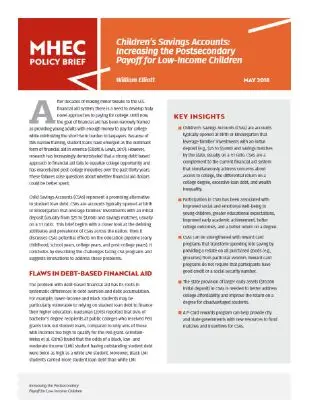Children’s Savings Accounts: Increasing the Postsecondary Payoff for Low-Income Children
fter decades of making minor tweaks to the U.S. financial aid system, there is a need to develop truly novel approaches to paying for college. Until now, the goal of financial aid has been narrowly framed as providing young adults with enough money to pay for college while minimizing the short-term burden to taxpayers. Because of this narrow framing, student loans have emerged as the dominant form of financial aid in America (Elliott & Lewis, 2017). However, research has increasingly demonstrated that a strong debt-based approach to financial aid fails to equalize college opportunity and has exacerbated post-college inequities over the past thirty years. These failures raise questions about whether financial aid dollars could be better spent.
Child Savings Accounts (CSAs) represent a promising alternative to student loan debt. CSAs are accounts typically opened at birth or kindergarten that leverage families’ investments with an initial deposit (usually from $25 to $1,000) and savings matches, usually on a 1:1 ratio. This brief begins with a closer look at the defining attributes and prevalence of CSAs across the nation. Then it discusses CSAs potential effects on the education pipeline (early childhood, school years, college years, and post-college years). It concludes by describing the challenges facing CSA programs and suggests innovations to address these problems.

